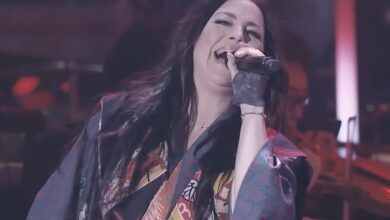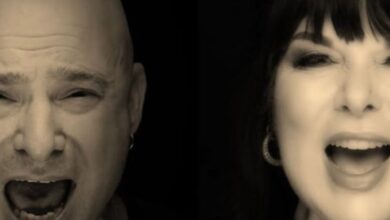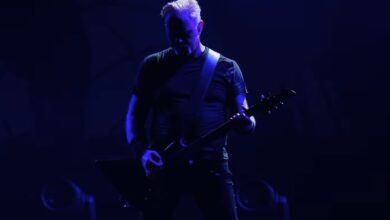Metallica Defies the Storm: Legendary “Master of Puppets” Performance in the Pouring Rain
Metallica’s legacy didn’t spring from thin air — it took shape in a humble garage at 3132 Carlson Boulevard in El Cerrito, California. Between 1983 and 1986, James, Lars, Kirk, and Cliff Burton turned that dusty space into a creative crucible. It was here, amid beer cans and neighborly chaos, that riffs for Ride the Lightning and Master of Puppets were born — the early blueprint for thrash metal’s seismic revolution.
That garage wasn’t just a rehearsal spot; it was a noisy, boozy salon of ambition. James, Lars, and Cliff lived upstairs, and nightly drinking sessions stretched into the early hours. Fans and friends showed up with cases of beer in hand, adding to the environment’s chaotic creativity — a raucous scene that fueled riffs and camaraderie alike.
Fast forward a few decades: the garage was torn down. But a friend — Andy Anderson from the Bay Area punk band Attitude Adjustment — saved eight pieces of its old wood. Those fragments, weathered and heavy with history, found their way to James. He saw in them not just wood, but a bridge back to the raw grit of Metallica’s roots.
Partnering with luthier Ken Lawrence, the wood became “Carl” — a guitar carved from the bones of that garage. The mission was clear: make it rustic, let the grain speak. You don’t feel a perfect sheen; you feel grooves in the finish. James wanted authenticity, a visceral connection not just in sound, but in touch and memory.
“Carl” isn’t just decorative. The neck’s inlay tells a story: James, Kirk, Lars, and the face of Cliff Burton are memorialized, as is the band’s move to San Francisco, Burton’s tragic passing, and the sense that his spirit still guides them. It’s a living chronicle, etched onto wood and metal — history you can play.
Since Carl’s debut, James has brought it out for Master of Puppets whenever possible. That moment on stage, when he cradles the instrument born from those formative years, creates a powerful emotional resonance — both for him, and for die‑hard fans who recognize the deep lineage behind the strings.
Which brings us to June 18, 2019, at Manchester’s Etihad Stadium. Metallica had committed to performing rain or shine — and as a monsoon unleashed itself onstage, they lived up to that vow. A downpour didn’t deter them; instead, it fueled one of the most exhilarating live renditions of Master of Puppets ever heard.
From fan-shot footage to pro‑shot videos, what’s striking is the ferocity of the rain. Cabling glistens, mics drip, and equipment trembles under the assault. Yet the band — laser‑focused — forges ahead. It’s not sloppy. It’s breathtaking. It’s a statement: Metallica doesn’t just endure weather; they harness it.
One vivid detail: as Lars pounds the drums, thunderous hits send water droplets exploding off the skins in slow‑motion arcs. That visual spectacle — water flying off his bright yellow kit — entrances the audience. It’s a rare convergence of meteorology and musicianship; truly epic, unforgettable.
Fans on Reddit were moved. One wrote, “I’m pretty impressed just watching James going through the chunkier bit after the interlude and imagining how irritating that must be.” Another observed, “Playing guitar while soaking wet is a lot harder to do than under normal conditions.” Their admiration underscores how extraordinary this performance was.
Loudwire captured the essence: “Metallica came to town… they said the show will go on rain or shine and they meant it, getting a bath from the heavens as they performed through a…” Fans knew the investment Metallica made in that moment — commitment squared against the elements — was something special.
Backstage, Lars reflected: “Camera angles on Lars Ulrich really seem to capture just how intense the rain was coming down.” He recalled the show as a celebration of grit — a testament to enduring spirit, years of touring, and a stage crew that makes the impossible possible nightly.
Beyond weather drama, the stage itself was a massive ring structure — part of their “M72” or WorldWired touring design. It spread the band in all directions, with four equally spaced drum kits so Lars could engage the crowd. At Manchester, that central stage under rain and thunder felt like a volcano chamber where music erupted from every side.
In more recent shows, like Munich’s 2024 downpour during the M72 tour, photos and video are outpacing even Manchester’s spectacle. Again, water cascades off the drums, cymbals shine under floodlights, and the crowd is drenched — soaked through but electrified. Fans and critics alike often say, “That was the best live Master of Puppets I’ve ever heard.”
What ties all this together is the aura of survival and legacy — from writing in a sweaty garage to wielding a guitar born of those walls, to performing that legacy in heavy rain under stadium lights. “Carl” carries the story, the drums manifest it physically, and the performance makes it real in a thousand weather‑soaked moments. This isn’t just rock; it’s old‑school creation, renewed nightly in spectacular fashion.





